Research on Seismic Performance of a Two-Story, Two-Span Underground Subway Station with Split Columns Based on the Quasi-Static Method
Abstract
:1. Introduction
2. The Split Column Technology
3. The Overview of the Subway Station
4. Finite Element Model
5. The Pushover Analysis of the Center Column
5.1. Analysis Methods
5.2. Analysis Results
6. The Pushover Analysis of Soil–Structure System
6.1. Analysis Methods
6.2. Analysis Results
7. Conclusions
- (1)
- When the cross-sectional area and the longitudinal reinforcement ratio is similar, the horizontal bearing capacity of split columns is reduced compared to traditional columns, and the stiffness of split columns is basically lower than that of traditional columns under various loading displacements.
- (2)
- Compared to traditional columns, split column components have better displacement capacity, and the ultimate inter-story drift ratio of split columns under high axial compression ratio is 1.5-fold higher than that of traditional columns.
- (3)
- Although the ability of split columns to share shear and bending moments is reduced compared to traditional columns, they still have higher vertical bearing capacity under larger horizontal deformations, and the damage to split columns is much smaller than that of traditional columns under the same inter-story displacement angle.
- (4)
- The working mechanism is to avoid the central column bearing excessive shear and bending forces, while fully utilizing the vertical support capacity and horizontal deformation capacity of split columns. Compared to traditional columns, the construction steps of split columns are more complex. To promote the application of split columns in underground structures, it is necessary to strengthen both experimental research and construction technology research.
Author Contributions
Funding
Institutional Review Board Statement
Informed Consent Statement
Data Availability Statement
Conflicts of Interest
References
- GB18306-2015; Seismic Ground Motion Parameters Zonation Map of China. Standardization Administration of China: Beijing, China, 2016. (In Chinese)
- Du, X.L.; Li, Y.; Xu, C.S.; Lu, D.; Xu, Z.; Jin, L. Review on damage causes and disaster mechanism of Daikai subway station during 1995 Osaka-Kobe Earthquake. Chin. J. Geotech. Eng. 2018, 40, 223–236. (In Chinese) [Google Scholar]
- Iida, H.; Hiroto, T.; Yoshida, N.; Iwafuji, M. Damage to Daikai subway station. Soils Found 1996, 36, 283–300. [Google Scholar] [CrossRef] [PubMed]
- Wang, W.L.; Wang, T.T.; Su, J.J.; Lin, C.H.; Seng, C.R.; Huang, T.H. Assessment of damage in mountain tunnels due to the Taiwan Chi-Chi earthquake. Tunn. Undergr. Space Technol. 2001, 16, 133–150. [Google Scholar] [CrossRef]
- Wang, Z.Z.; Gao, B.; Jiang, Y.J.; Yuan, S. Investigation and assessment on mountain tunnels and geotechnical damage after the Wenchuan earthquake. Sci. China Ser. E Technol. Sci. 2009, 52, 546–558. [Google Scholar] [CrossRef]
- Kuesel, T.R. Earthquake design criteria for subways. J. Struct. Div. 1969, 95, 1213–1231. [Google Scholar] [CrossRef]
- Liu, J.B.; Zhang, X.B. Practical seismic analysis of large underground structures: Theory and application. Sci. China Technol. Sci. 2018, 61, 1417–1425. [Google Scholar] [CrossRef]
- Jiang, L.; Chen, J.; Li, J. Seismic response of underground utility tunnels: Shaking table testing and FEM analysis. Earthq. Eng. Eng. Vib. 2010, 9, 555–567. [Google Scholar] [CrossRef]
- Ulgen, D.; Saglam, S.; Ozkan, M.Y. Dynamic response of a flexible rectangular underground structure in sand: Centrifuge modeling. Bull. Earthq. Eng. 2015, 13, 2547–2566. [Google Scholar]
- Jiang, X.; Wang, F.; Yang, H.; Sun, G.; Niu, J. Dynamic Response of Shallow-Buried Small Spacing Tunnel with Asymmetrical Pressure: Shaking Table Testing and Numerical Simulation. Geotech. Geol. Eng. 2018, 36, 2037–2055. [Google Scholar] [CrossRef]
- An, X.; Shawky, A.A.; Maekawa, K. The collapse mechanism of a subway station during the Great Hanshin earthquake. Cem. Concr. Compos. 1997, 19, 241–257. [Google Scholar] [CrossRef]
- Huo, H.; Bobet, A.; Fernández, G.; Ramírez, J. Load transfer mechanisms between underground structure and surrounding ground: Evaluation of the failure of the Daikai station. J. Geotech. Geoenviron. Eng. 2005, 131, 1522–1533. [Google Scholar] [CrossRef]
- Gao, F.; Shi, Y.C.; Yan, S.H.; Guan, B.S. Study of two shock absorption measures in tunnel. Chin. J. Rock Mech. Eng. 2005, 24, 222–229. (In Chinese) [Google Scholar] [CrossRef]
- Zhao, W.; Chen, W.; Yang, D. Interaction between strengthening and isolation layers for tunnels in rock subjected to SH waves. Tunn. Undergr. Space Technol. 2018, 79, 121–133. [Google Scholar] [CrossRef]
- Chen, Z.; Liang, S.; Shen, H.; He, C. Dynamic centrifuge tests on effects of isolation layer and cross-section dimensions on shield tunnels. Soil Dyn. Earthq. Eng. 2018, 109, 173–187. [Google Scholar] [CrossRef]
- Ma, C.; Lu, D.; Du, X. Seismic performance upgrading for underground structures by introducing sliding isolation bearings. Tunn. Undergr. Space Technol. 2018, 74, 1–9. [Google Scholar] [CrossRef]
- Xu, Z.; Du, X.; Xu, C.; Han, R. Numerical analyses of seismic performance of underground and aboveground structures with friction pendulum bearings. Soil Dyn. Earthq. Eng. 2020, 130, 105967. [Google Scholar] [CrossRef]
- Chen, Z.; Chen, W.; Bian, G. Seismic performance upgrading for underground structures by introducing shear panel dampers. Adv. Struct. Eng. 2014, 17, 1343–1357. [Google Scholar] [CrossRef]
- Chen, Z.; Zhao, H.; Lou, M. Seismic performance and optimal design of framed underground structures with lead-rubber bearings. Struct. Eng. Mech. 2016, 58, 259–276. [Google Scholar] [CrossRef]
- Du, X.L.; Wang, Z.L.; Liu, H.T. Study of a seismic new system of underground frame structure based on toughness design. Technol. Earthq. Disaster Prev. 2018, 13, 493–501. (In Chinese) [Google Scholar]
- Chen, Z.; Zhou, Y. Seismic performance of framed underground structures with self-centering energy-dissipation column base. Adv. Struct. Eng. 2019, 22, 2809–2822. [Google Scholar] [CrossRef]
- Yue, C.; Zheng, Y.; Deng, S. Shaking table test study on seismic performance improvement for underground structures with center column enhancement. J. Earthq. Tsunami 2019, 13, 1950009. [Google Scholar] [CrossRef]
- Ma, C.; Wang, Z.H.; Lu, D.C.; Du, X. Seismic damage evaluation of CFRP-strengthened columns in subway stations. Chin. J. Geotech. Eng. 2020, 42, 2249–2256. (In Chinese) [Google Scholar]
- Bu, X.; Ledesma, A.; López-Almansa, F. Low lateral stiffness underground structures for improved seismic performance. Appl. Kobe Daikai Stn. Eng. Struct. 2023, 291, 116388. [Google Scholar]
- Bu, X.; Xu, Z.; Ledesma, A.; López-Almansa, F. Seismic target drifts for underground railway stations. Cases of traditional rigid connections and sliding interior columns. Tunn. Undergr. Space Technol. 2024, 144, 105555. [Google Scholar] [CrossRef]
- Li, Z.X. Theory and technology of split reinforced concrete columns. Eng. Mech. 2005, 22, 128–140. (In Chinese) [Google Scholar] [CrossRef]
- Li, Z.X.; Hao, Y.C.; Zhang, J.Y. Research on seismic behavior of interior beam-column joints of reinforced concrete frames. J. Build. Struct. 2001, 22, 55–60. (In Chinese) [Google Scholar]
- Hao, Y.C.; Hu, Q.C.; Xu, Y.F.; Kang, G.Y. Experimental study on bearing capacity of separated columns under horizontal cyclic loading. J. Build. Struct. 1999, 20, 18–25. (In Chinese) [Google Scholar]
- Li, R.W. Experimental Study on the Mechanical Behavior of Split Columns with Different Separation Ratios. Master’s Thesis, Yantai University, Yantai, China, 2017. (In Chinese). [Google Scholar]
- Li, Z.X.; Hao, Y.C.; Zhou, B.; Kang, G.; Hu, Q.; Xu, Y. Model experimental study on seismic behavior of reinforced concrete frame with split columns. J. Build. Struct. 2003, 24, 1–10. (In Chinese) [Google Scholar]
- Ma, Q.Y.; Zhao, G.Q.; Jiang, C.Y. Experimental research on seismic performance of central column in subway station. Build. Struct. 2021, 51, 77–85. (In Chinese) [Google Scholar]
- Du, X.L.; Xu, Z.G.; Xu, C.S. n-Shape Prefabricated Connective Split Column for Underground Structures. U.S. Patent 10669719 B2, 18 December 2023. [Google Scholar]
- Xu, C.S.; Wang, Y.X.S.; Du, X.L.; Xu, Z.; Zhang, Z. Seismic mitigation effects of split columns in underground station structures. Chin. J. Geotech. Eng. 2021, 43, 624–633. (In Chinese) [Google Scholar]
- Hibbitt; Karlsson; Sorensen. ABAQUS/Explicit: User’s Manual; Hibbitt, Karlsson and Sorenson Incorporated: Birmingham, AL, USA, 2001. [Google Scholar]
- Kampitsis, A.E.; Sapountzakis, E.J.; Giannakos, S.K.; Gerolymos, N.A. Seismic soil-pile-structure kinematic and inertial interaction-A new beam approach. Soil Dyn. Earthq. Eng. 2013, 55, 211–224. [Google Scholar] [CrossRef]
- Bu, X.; Ledesma, A.; López-Almansa, F. Novel seismic design solution for underground structures. Case study of a 2-story 3-bay subway station. Soil Dyn. Earthq. Eng. 2022, 153, 107087. [Google Scholar] [CrossRef]
- Yang, J.; Zhuang, H.; Wang, W.; Zhou, Z.; Chen, G. Seismic performance and effective isolation of a large multilayered underground subway station. Soil Dyn. Earthq. Eng. 2021, 142, 106560. [Google Scholar]
- Nie, X.; Liu, T. Experimental and numerical study on bending behavior of concrete-concrete composite beams. China Civ. Eng. J. 2022, 55, 14–25. (In Chinese) [Google Scholar]
- Lee, J.; Fenves, G.L. Plastic-Damage Model for Cyclic Loading of Concrete Structures. J. Eng. Mech. 1998, 124, 892–900. [Google Scholar] [CrossRef]
- Lubliner, J.; Oliver, J.; Oller, S.; Oñate, E. A plastic-damage model for concrete. Int. J. Solids Struct. 1989, 25, 299–326. [Google Scholar] [CrossRef]
- Zhuang, H.; Hu, Z.; Wang, X.; Chen, G. Seismic responses of a large underground structure in liquefied soils by FEM numerical modelling. Bull. Earthq. Eng. 2015, 13, 3645–3668. [Google Scholar] [CrossRef]
- Xu, Z.; Zhuang, H.; Xia, Z.; Yang, J.; Bu, X. Study on the effect of burial depth on seismic response and seismic intensity measure of underground structures. Soil Dyn. Earthq. Eng. 2023, 166, 107782. [Google Scholar] [CrossRef]
- Jiang, J.; El Nggar, H.M.; Xu, C.; Zhong, Z.; Du, X. Effect of ground motion characteristics on seismic fragility of subway station. Soil Dyn. Earthq. Eng. 2021, 143, 106618. [Google Scholar] [CrossRef]
- Jiang, J.; El Naggar, M.H.; Xu, C.; Du, X. Effect of parameters associated with soil-to-structure relative stiffness on seismic fragility curves of subway station. Tunn. Undergr. Space Technol. 2023, 135, 105057. [Google Scholar] [CrossRef]
- Jiang, J.; El Naggar, M.H.; Du, X.; Du, X. Seismic fragility curves for shallow buried subway station using pushover-based method. Tunn. Undergr. Space Technol. 2023, 135, 105059. [Google Scholar] [CrossRef]
- Xu, Z.; Du, X.; Xu, C.; Jiang, J.; Han, R. Simplified equivalent static methods for seismic analysis of shallow buried rectangular underground structures. Soil Dyn. Earthq. Eng. 2019, 121, 1–11. [Google Scholar] [CrossRef]
- Liu, J.B.; Wang, W.H.; Dasgupta, G. Pushover analysis of underground structures: Method and application. Sci. China Technol. Sci. 2014, 57, 423–437. [Google Scholar] [CrossRef]
- Jiang, J.; Xu, C.; El Naggar, H.M.; Du, X.; Xu, Z.; Assaf, J. Improved pushover method for seismic analysis of shallow buried underground rectangular frame structure. Soil Dyn. Earthq. Eng. 2021, 140, 106363. [Google Scholar] [CrossRef]
- Du, X.; Jiang, J.; El Naggar, M.H.; Xu, C.; Xu, Z. Interstory drift ratio associated with performance objectives for shallow-buried multistory and span subway stations in inhomogeneous soil profiles. Earthq. Eng. Struct. Dyn. 2021, 50, 655–672. [Google Scholar] [CrossRef]
- Zhong, Z.; Shen, Y.; Zhao, M.; Li, L.; Du, X. Seismic performance evaluation of two-story and three-span subway stations in different engineering sites. J. Earthq. Eng. 2022, 26, 7505–7535. [Google Scholar] [CrossRef]



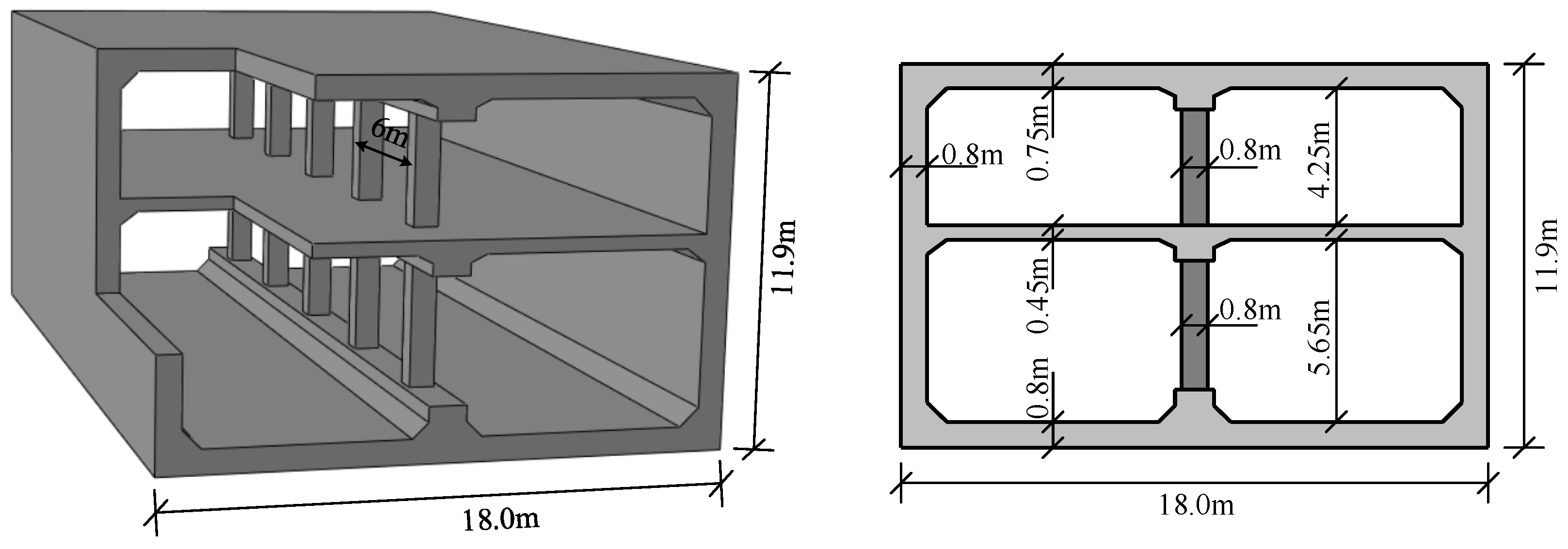


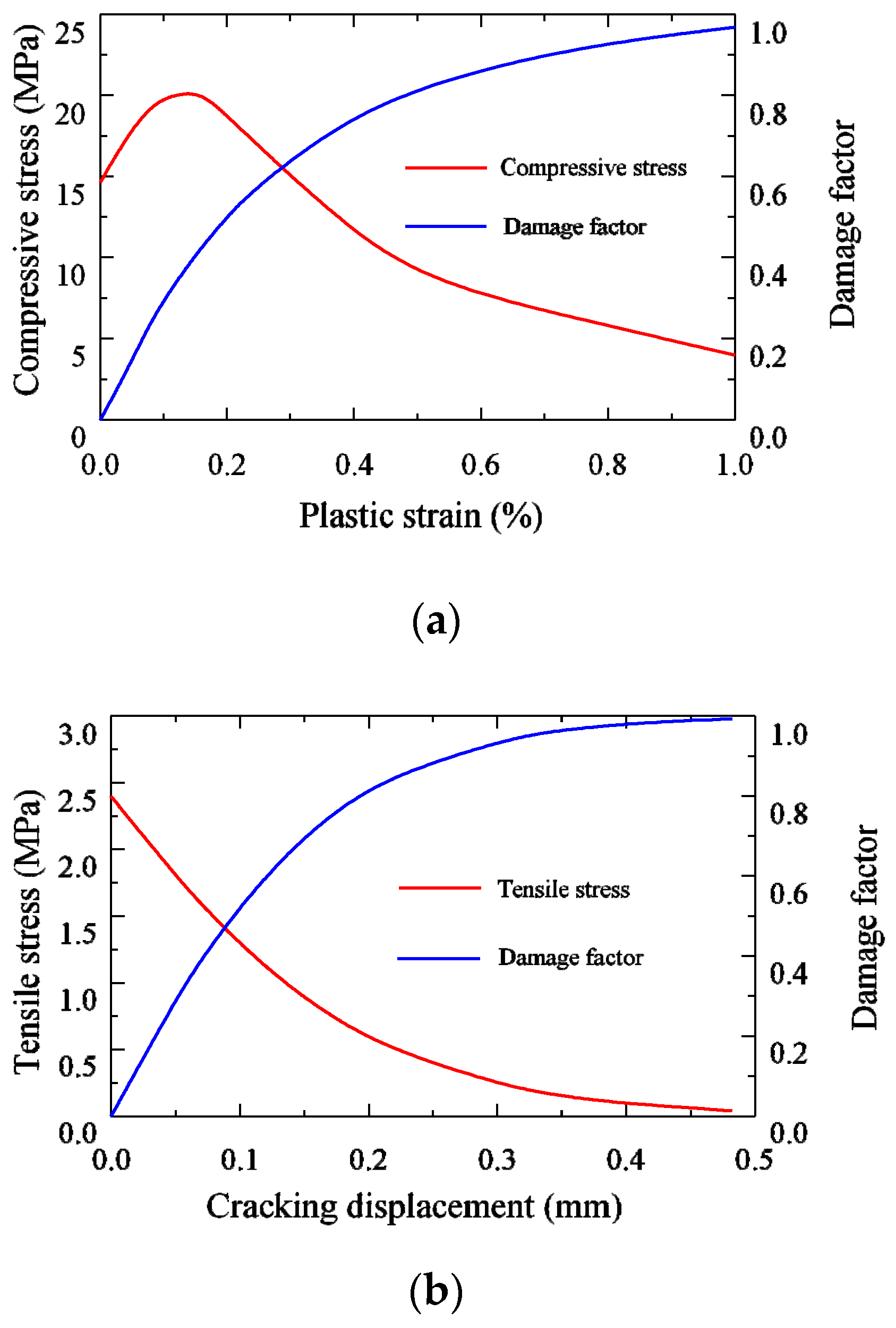
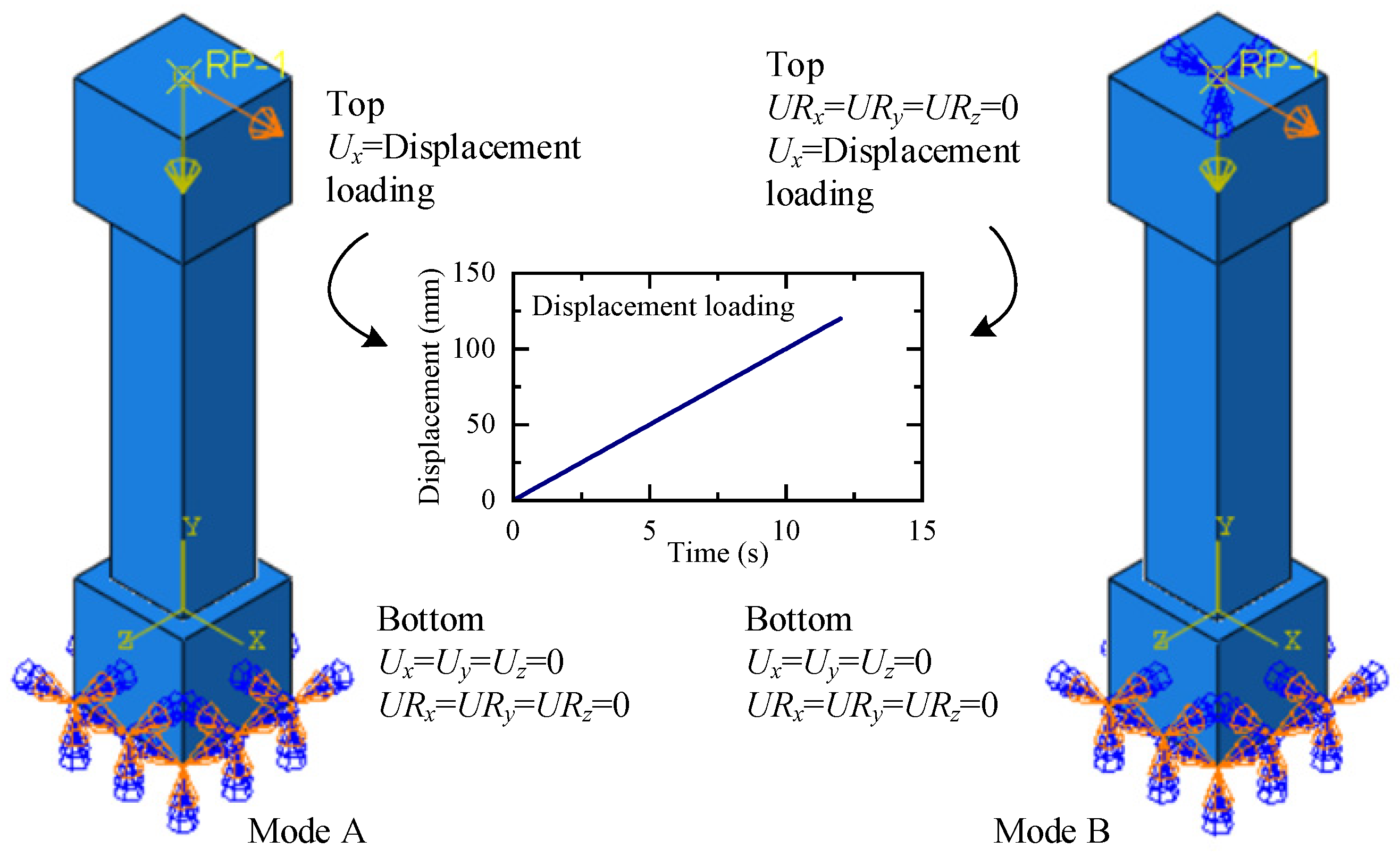
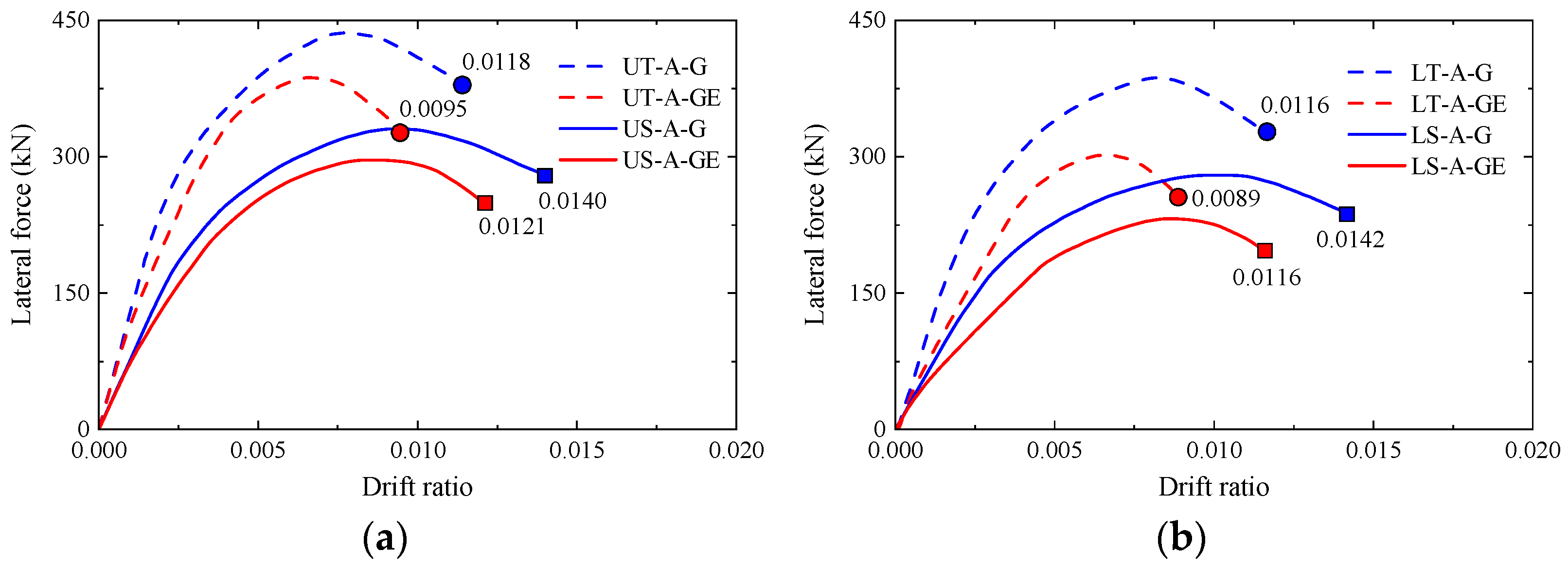

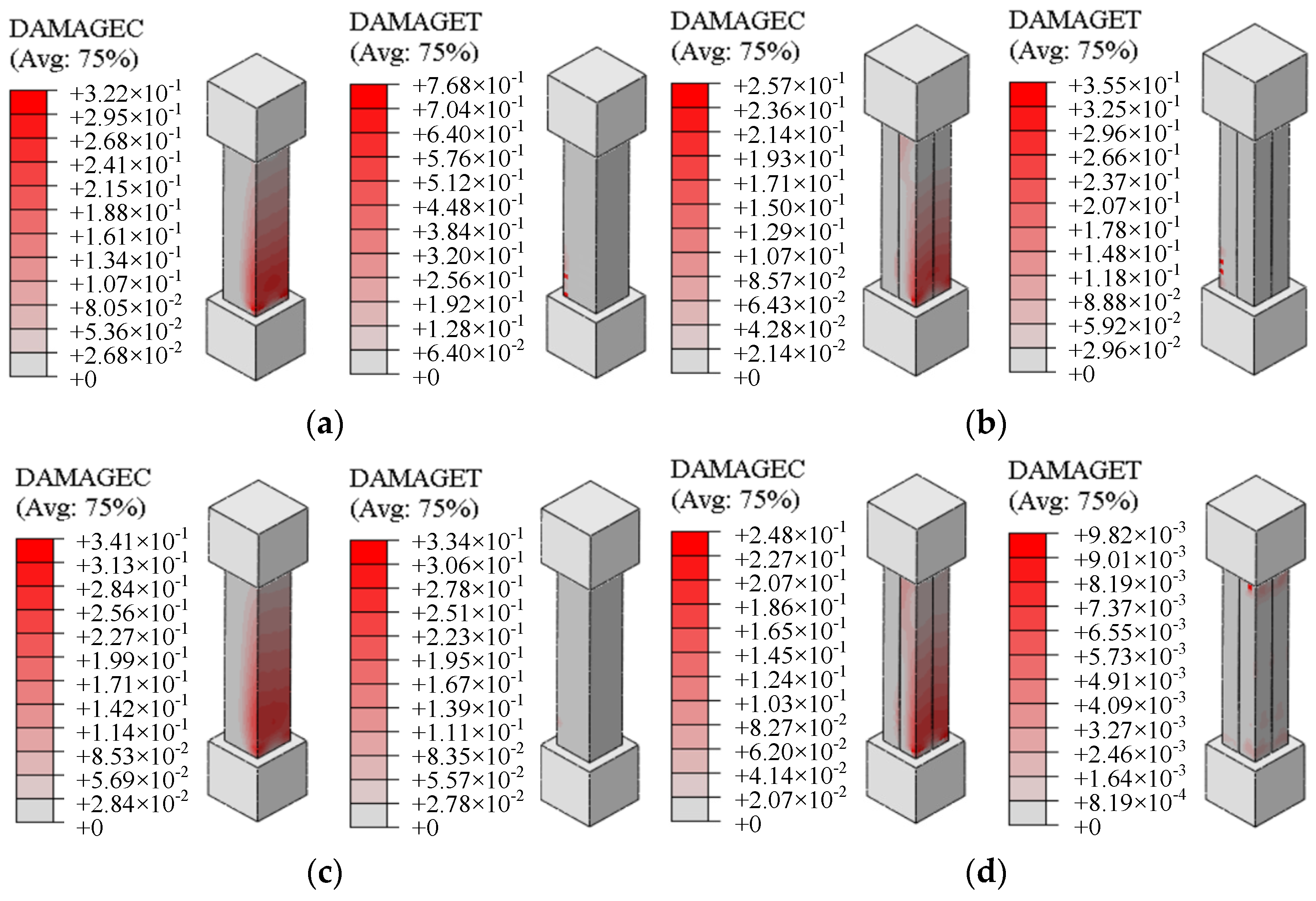
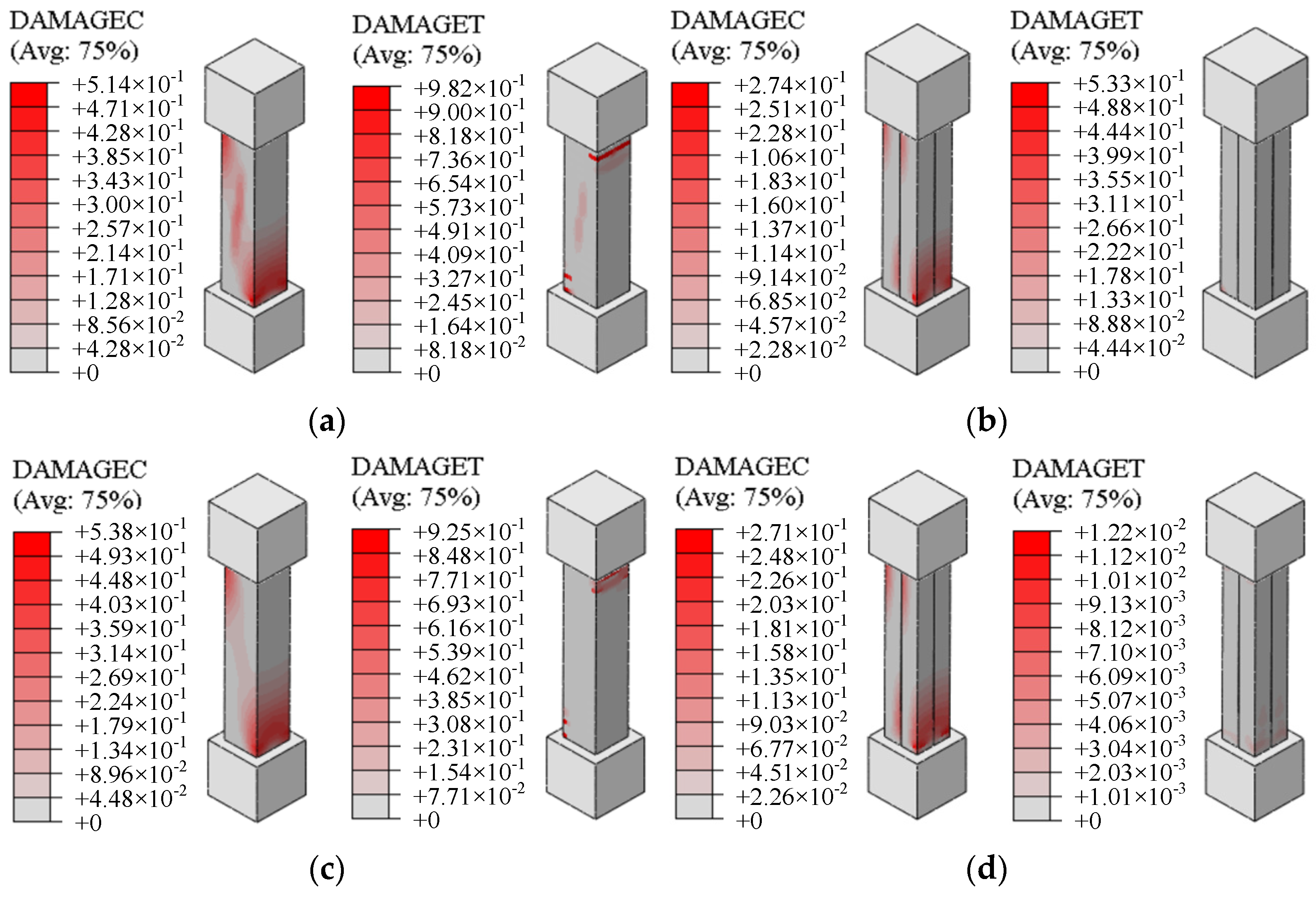


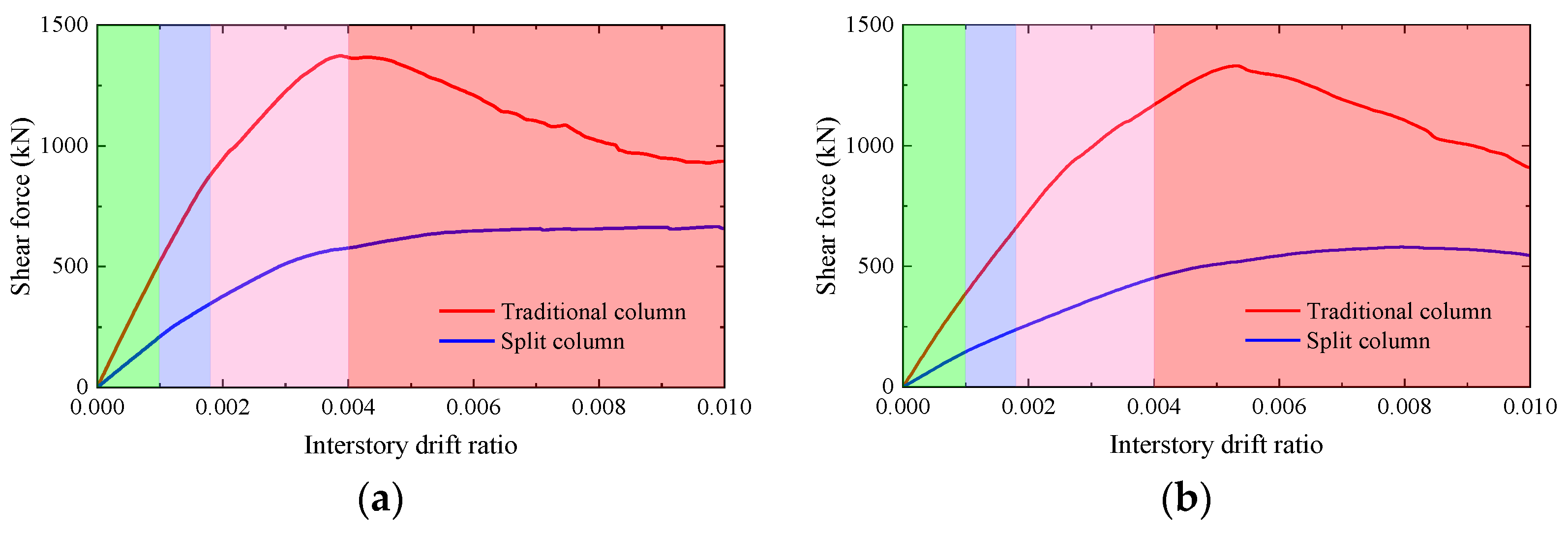

| Parameters | Value | Parameters | Value |
|---|---|---|---|
| Density | 2450 kg/m3 | Limited compressive yield stress | 20.1 MPa |
| Elastic modulus | 30 GPa | Initial tensile yield stress | 2.4 MPa |
| Poisson’s ratio | 0.18 | Compression stiffness recovery parameter | 1 |
| Dilation angle | 36.31° | Tensile stiffness recovery parameter | 0 |
| Initial compressive yield stress | 13 MPa |
| Plastic Strain | Compressive Stress (MPa) | Compressive Damage Factor | Plastic Strain | Compressive Stress (MPa) | Compressive Damage Factor |
|---|---|---|---|---|---|
| 0 | 14.64 | 0 | 2.4 × 10−3 | 17.25 | 0.566 |
| 4.0 × 10−4 | 17.33 | 0.113 | 3.6 × 10−3 | 12.86 | 0.714 |
| 8 × 10−4 | 19.44 | 0.246 | 5.0 × 10−3 | 8.66 | 0.824 |
| 1.2 × 10−3 | 20.10 | 0.341 | 7.5 × 10−3 | 6.25 | 0.922 |
| 1.6 × 10−3 | 20.18 | 0.427 | 1.0 × 10−2 | 3.98 | 0.969 |
| 2.0 × 10−3 | 18.72 | 0.501 |
| Cracking Displacement (mm) | Tensile Stress (MPa) | Tensile Damage Factor | Cracking Displacement (mm) | Compression Stress (MPa) | Tensile Damage Factor |
|---|---|---|---|---|---|
| 0 | 2.400 | 0 | 0.308 | 0.219 | 0.944 |
| 0.066 | 1.617 | 0.381 | 0.351 | 0.147 | 0.965 |
| 0.123 | 1.084 | 0.617 | 0.394 | 0.098 | 0.978 |
| 0.173 | 0.726 | 0.763 | 0.438 | 0.066 | 0.987 |
| 0.220 | 0.487 | 0.853 | 0.482 | 0.042 | 0.992 |
| Soil Layer | Thickness (m) | Density (kg/m3) | Shear Wave Speed (m/s) | Poisson’s Ratio | A | B | γ0 (10−4) |
|---|---|---|---|---|---|---|---|
| Soil layer I | 4 | 1900 | 200 | 0.3 | 1.02 | 0.35 | 4.0 |
| Soil layer II | 4 | 1950 | 260 | 0.3 | 1.05 | 0.34 | 3.5 |
| Soil layer III | 4 | 1980 | 310 | 0.3 | 1.10 | 0.35 | 3.8 |
| Soil layer IV | 8 | 1950 | 335 | 0.3 | 1.10 | 0.35 | 3.8 |
| Soil layer V | 10 | 2000 | 430 | 0.3 | 1.10 | 0.35 | 3.8 |
| Soil layer VI | 10 | 2100 | 520 | 0.3 | 1.20 | 0.35 | 2.5 |
| Case | Column | Cross Section | Pushover Mode | Horizontal Load |
|---|---|---|---|---|
| UT-A-G | upper | traditional | Mode A | Gravity |
| UT-A-GE | upper | traditional | Mode A | Gravity and earthquake load |
| UT-B-G | upper | traditional | Mode B | Gravity |
| UT-B-GE | upper | traditional | Mode B | Gravity and earthquake load |
| US-A-G | upper | split | Mode A | Gravity |
| US-A-GE | upper | split | Mode A | Gravity and earthquake load |
| US-B-G | upper | split | Mode B | Gravity |
| US-B-GE | upper | split | Mode B | Gravity and earthquake load |
| LT-A-G | lower | traditional | Mode A | Gravity |
| LT-A-GE | lower | traditional | Mode A | Gravity and earthquake load |
| LT-B-G | lower | traditional | Mode B | Gravity |
| LT-B-GE | lower | traditional | Mode B | Gravity and earthquake load |
| LS-A-G | lower | split | Mode A | Gravity |
| LS-A-GE | lower | split | Mode A | Gravity and earthquake load |
| LS-B-G | lower | split | Mode B | Gravity |
| LS-B-GE | lower | split | Mode B | Gravity and earthquake load |
Disclaimer/Publisher’s Note: The statements, opinions and data contained in all publications are solely those of the individual author(s) and contributor(s) and not of MDPI and/or the editor(s). MDPI and/or the editor(s) disclaim responsibility for any injury to people or property resulting from any ideas, methods, instructions or products referred to in the content. |
© 2024 by the authors. Licensee MDPI, Basel, Switzerland. This article is an open access article distributed under the terms and conditions of the Creative Commons Attribution (CC BY) license (https://creativecommons.org/licenses/by/4.0/).
Share and Cite
Xu, Z.; Xia, Z.; Bu, X.; Han, R. Research on Seismic Performance of a Two-Story, Two-Span Underground Subway Station with Split Columns Based on the Quasi-Static Method. Appl. Sci. 2024, 14, 4077. https://doi.org/10.3390/app14104077
Xu Z, Xia Z, Bu X, Han R. Research on Seismic Performance of a Two-Story, Two-Span Underground Subway Station with Split Columns Based on the Quasi-Static Method. Applied Sciences. 2024; 14(10):4077. https://doi.org/10.3390/app14104077
Chicago/Turabian StyleXu, Zigang, Zongyao Xia, Xiangbo Bu, and Runbo Han. 2024. "Research on Seismic Performance of a Two-Story, Two-Span Underground Subway Station with Split Columns Based on the Quasi-Static Method" Applied Sciences 14, no. 10: 4077. https://doi.org/10.3390/app14104077




